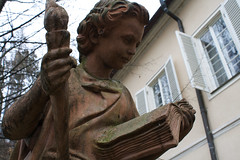Hey, there. I know it’s been a long time since we’ve seen each other, but I want to you know that I’ve been thinking about you while we’ve been apart. I’ve had a busy schedule this past month, and it has kept me away from you, at least in this forum, and I want you to know that I have missed you very much. I hope you can forgive me for being away so long.
Anyway, I wanted to share some of the things that I have written for Blogcritics in recent months:
The World Is Your Litter Box: A How-to Manual for Cats by Quasi, with Minor Help from Steve Fisher
by Quasi, with Minor Help from Steve Fisher
This book is by no means a serious psychological study of cat behavior or cat-human relationships, but it does provide some insight into the latter. The main thing I took away from this book is that no matter what cats do to irritate humans, most of us easily melt into a puddle of mush when our pets show affection. Think of how much calmer rush hour could be if we all had a purring cat in our laps? [more]
Amy Ray – Didn’t It Feel Kinder
Even though Ray worked with some of the same musicians on Didn’t It Feel Kinder as she did for Stag and Prom, this album has a completely different feel to it. The message is the same, but the medium has shifted. Fans expecting a punk rock album may be disappointed, but I think that Didn’t It Feel Kinder will find its audience among listeners who enjoy the message as much as the medium. [more]
Alū – Lobotomy Sessions
Each of the ten tracks are what some have described as “cinematic soundscapes.” Think of them as an art house film told in three to five minutes. Horror, science fiction, political commentary, drama… whatever your movie type of choice, there is likely to be a track on this album that draws on elements of it. It’s a veritable film festival of sound. [more]
Uh Huh Her – Common Reaction
…don’t go looking for much depth in the lyrics. Although the insert devotes a full six panels to the poetry, it’s by far the weakest aspect of the album. Some of the more uninspired lines are held up quite well with the musical arrangements, so unless you’re paying close attention, you’ll be too distracted by the beats and melody to notice. In any case, it’s slightly better than the drivel on Top 40 radio. [more]
Cordero – De Dónde Eres
Past albums have featured a mix of English- and Spanish-language songs, but regardless of the language of the lyrics, the message was frequently delivered in packages spiced with horns and beats that made it impossible to sit still. De Dónde Eres heightens the Latin rhythms, instrumentation, and mood. Alternating between contemplative, strident, and festive arrangements, the album and the band are unified by Ani’s passionate lyrics and delivery. [more]
Awake, My Soul: The Story of the Sacred Harp (Standard Edition)
Most likely, the audience that will pick up this DVD will already be familiar with shape note singing. However, I think that anyone interested in Early American music should also take the time to view it. The filmmakers, both Sacred Harp singers themselves, have created a piece of work that, much like shape note music itself, is simultaneously utilitarian and glorious. [more]
The Age of Rockets – Hannah
Hannah is designed to be a palindrome of an album. The first five songs reflect the last five songs, with the middle sixth track creating the pivot point. Listening to an album that is half-music, half-mathematical art piece can sometimes be disappointing, but despite (or because of) this structure, Hannah stands on its own as a cohesive and fun collection of delicately blended electronic/organic tunes. Honestly, I hardly noticed the relationship between the songs in the dozen or so times I have listened to this album over the past couple of months. [more]
It’s the Great Pumpkin, Charlie Brown
Until watching it again in this remastered deluxe edition, it had never occurred to me that the film has a structure that allows for that kind of repeat showings. Several of the characters refer to Linus’ past obsession with the Great Pumpkin, and the implication that the same thing happens every Halloween makes it easy to suspend disbelief and watch it anew every year as though you weren’t already familiar with the plot and events. Maybe, just maybe, this year things will be different and the Great Pumpkin will rise out of the patch! [more]

